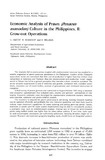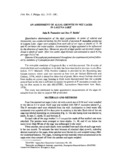Search
Now showing items 11-20 of 179
A probiotic Bacillus strain containing amorphous poly-beta-hydroxybutyrate (PHB) stimulates the innate immune response of Penaeus monodon postlarvae
(Elsevier, 2017)
In this study, the PHB-accumulating Bacillus sp. JL47 strain (capable of accumulating 55% PHB on cell dry weight) was investigated for its effects on the immune response of giant tiger shrimp (Penaeus monodon) postlarvae ...
Feeding regimes in relation to reproduction and survival of ablated Penaeus monodon
(University of the Philippines at Los Baños, 1979)
Pond-reared P. monodon were stocked in four 12-cu m flowthrough maturation tanks at 25 males and 50 females per tank; females were unilaterally ablated. The combinations of feeds for the morning and afternoon rations were ...
Economic analysis of prawn (Penaeus monodon) culture in the Philippines, II: Grow-out operations
(Asian Fisheries Society, 1996)
The dramatic fall in prawn (Penaeus monodon) prices coupled with environmental concerns has resulted in a relative stagnation of prawn grow-out operations in the Philippines. Leaders of the Philippine aquaculture sector ...
Induction of immunity and resistance to white spot syndrome virus (WSSV) in shrimp Penaeus monodon (Fabricius) by synthetic oligodeoxynucleotide and bacterial DNA
(University of the Philippines Los Baños, 2012)
Shrimps like all invertebrates are believed to lack true adaptive immunity but recent evidence indicate that they can be protected against pathogenic organisms by priming their immune system with immunostimulatory substances. ...
Evaluation of dietary freeze-dried Chaetoceros calcitrans supplementation to control Vibrio harveyi infection on Penaeus monodon juvenile
(Elsevier, 2014)
Effects of supplementation of diets with freeze-dried Chaetoceros calcitrans to control Vibrio harveyi infection are evaluated through immune responses, and disease resistance of juvenile Penaeus monodon. Total lipid and ...
Economic assessment of commercial hatchery production of milkfish (Chanos chanos Forsskal) fry
(John Wiley and Sons, 1999)
The economic viabilities of two types of commercial hatchery milkfish (Chanos chanos) fry operations were assessed and compared. Based on the actual cost of input, the physical facilities, and the potential production ...
Economic analysis of prawn (Penaeus monodon) culture in the Philippines, I. Hatchery operations
(Asian Fisheries Society, 1995)
High prices of prawn (Penaeus monodon) fry, profitability of hatchery operations, and a low cost hatchery design introduced by the Southeast Asian Fisheries Development Center attracted millions of dollars of investments ...
Evidence of WSSV transmission from the rotifer (Brachionus plicatilis) to the black tiger shrimp (Penaeus monodon) postlarvae and means to control rotifer resting eggs using industrial disinfectants
(Bioflux, 2012)
Rotifers are considered possible vectors of the white spot syndrome virus (WSSV) and have been implicated in its recurrence in pond-cultured shrimp. However, direct evidence of the transmission and the pathogenicity of ...
Fish predation on mangrove-associated penaeids: The role of structures and substrate
(Elsevier, 1997)
The effect of habitat structure and substratum on predation of the greasyback shrimp Metapenaeus ensis (De Haan), white shrimp Penaeus merguiensis De Man and tiger shrimp Penaeus monodon Fabricius by sea bass Lates calcarifer ...
An assessment of algal growth in net cages in Laguna Lake
(Fisheries Research Society of the Philippines, 1981)
Quantitative determination of the algal population, in terms of cells/ml and biomass/ml, was conducted during the first month of growing P. monodon postlarvae in Laguna Lake. Algae were sampled from each side of net cages ...











